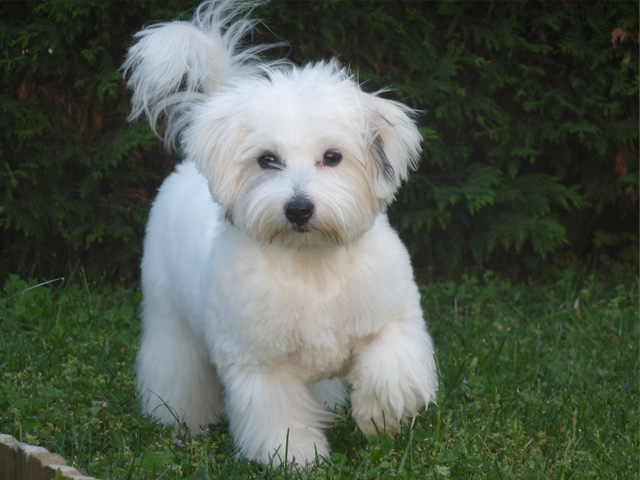
Coton de Tulear

Navigate through the tabs
Navigate through the tabs below to view the breed's info of your interest.
The breed's info is divided in four sections; namely:
the breed's history ,
the breed's main stats ,
the dog's potential health issues
and finally, how the breed scored in 26 different categories.
All the above information should give you a respectively good overview for the dog of your interest.
Dog Breed's Main Info
The Breed's History:
The Coton de Tulear developed on the island of Madagascar and is still the island's national dog. It is believed that the Tenerife dog was brought to Madagascar and mated with a dog of the island, creating an unexpected result.
The Coton's ancestors were possibly brought to Madagascar in the 16th and 17th centuries aboard pirate ships. Madagascar was a haven for pirates and pirate graveyards can still be seen there.
Pirates established a base on St. Mary's Island, Madagascar and some of them took Malagasy wives. Whether the dogs were brought along to control rats on the ships, as companions for long voyages, or were confiscated from other ships as booty, no one knows. Tulear is a port now also known as Toliara. The Coton is of the Bichon dog type, linked most closely to the Bichon Tenerife and the Tenerife Terrier.
There have been many stories circulating about the history of the Coton in recent years, most of them untrue. The Coton de Tulear was never feral on Madagascar. It did not hunt wild boar or alligators, as its size, strength, and demeanor can disprove easily.
It was a companion dog of the Merina (the ruling tribe) in Madagascar. It has very little prey drive and is not a hunting dog.
The cottony coat may be the result of a single gene mutation. This small, friendly dog caught the fancy of the Malagasy royalty and they were the only people allowed to keep Cotons. When Dr. Robert Jay Russell discovered the breed in Madagascar in 1973 and brought the first ones to America, he coined the phrase the Royal Dog of Madagascar and the name stuck.
They were also imported occasionally into France by returning French colonists, but were not officially imported to Europe until the 1970s. In 1974, Madagascar released a stamp with the image of the Coton, affirming their status nation's "royal dog".
The Coton de Tulear was first formally recognised as a breed by the Societe Centrale Canine (the French national kennel club) in 1970 and was accepted by the Federation Cynologique Internationale, which published the breed standard in 1972.
The Coton de Tulear is recognised internationally through the Federation Cynologique Internationale and by major kennel clubs (The Kennel Club (UK) in the Toy Group, and the United Kennel Club (US) in the Companion Group), using standards based upon the Federation Cynologique Internationale standard.
The breed is not recognised by the American Kennel Club, the New Zealand Kennel Club, or the Australian Kennel Union. It also may be recognised in the English-speaking world by any of the very large number of minor registries, clubs, and internet-based dog registry businesses.
In the United States, another standard for the Coton de Tulear was developed based upon the breed in Madagascar in 1974 by a biologist, Dr. Robert Jay Russell. Russell established the Coton de Tulear Club of America in 1976 and was opposed to American Kennel Club recognition.
The Coton de Tulear entered the American Kennel Club Foundation Stock Service (their first step in breed recognition) in 1996, and became a fully recognized breed on July 1st, 2014. The American Kennel Club Parent Club for the breed is the United States of America Coton de Tulear Club.
Country of Origin:
Madagascar
Breed Group:
Companion
Height:
8 inches to 1 foot (20,32 to 30,48 cm)
Weight:
8 to 13 pounds (3,63 to 5,9 Kg)
Life Span:
14 to 19 years
Potential Health Issues:
Luxating Patellas,
Hip Dysplasia,
Progressive Retinal Atrophy (PRA)
Adaptability
Apartment Living:
First Time Owners:
Sensitivity:
Being Alone:
Cold Weather:
Hot Weather:
Friendliness
Affection With Family:
With Kids:
With Dogs:
With Strangers:
Health and Grooming
Shedding:
Drooling:
Easy To Groom:
Overall Health:
Weight Gain Potential:
Size:
Training
Easiness:
Intelligence:
Mouthiness:
Prey Drive:
Barking or Howling:
Wanderlust:
Need For Exercise
Energy Level:
Intensity:
Exercise Needs:
Playfulness:
Our Mobile Application
Check out Our Mobile Application "Dog Breeds Central"
